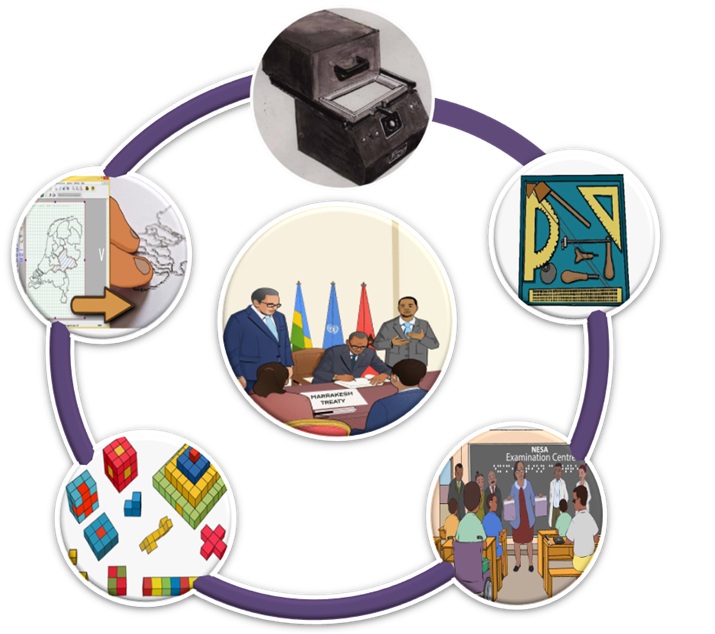Weekly outline
General Introduction



Module aim
This module aims at introducing the trainee to the Advanced Braille. It also intends to inform the trainee about the importance of using Advanced English Braille.
This Advanced English braille system is a result of combining codes from the existing braille systems. These systems include Standard English Braille (SEB), Braille mathematics notation, English Braille American Edition (Literary Braille), Nemeth Braille Code for mathematics and science and Braille Science. Each of the unit elaborates the indicated contents and provides practice exercises for you.
Module overall Learning Outcomes
By the end of this module, you should be able to:
- Understand the concept of Advanced English Braille
- Read, write, and transcribe the Advanced English Braille effectively.
- Apply Advanced English Braille for proper teaching and improved educational services for people with visual difficulties and other difficulties
Teaching, learning & Assessment strategies
The best way to cover and achieve the learning outcomes, the resources will be given to you together with the e-tivities with clearly indicated the task and resources related to the activity, you are requested to check the deadline each activity, be active, share ideas with classmates, for assessment online quiz for self-checking understanding and final quiz for evaluation a completed unit, and forum discussion for learning and assessment will be provided as well. you will interact with your facilitator in both mode of delivery face to face and online (live video conference will be organized apart from the resources that will be given to you, you are requested to do more research.
Module Facilitators
UR-CE Team

1. Study manual: Click here to download and keep the pdf file on your gadget
2. Module resources: Click here
Unit 1: Introduction to Braille and Braille equipment

This unit introduces you to the concept of English Braille and rationale of advanced English Braille

By the end of this unit, you should be able to:
- Differentiate forms of English Braille
- Explain the importance of advanced English Braille
- Discuss your contribution to the development of Rwandan Braille codes

Topic 1.1: The concept of English Braille
Topic 1.2: Rationale of Advanced English BrailleUnit 2: Grade II English Braille

This unit introduces you to the Braille contractions and abbreviations (also known as short-forms) used in English Braille.. We shall use Standard English Braille, with capitals, along with Braille Mathematics Notation, both of which are British Braille. In Grade 2 Braille, contractions and other short forms are employed to cut down on the space used for writing braille. Contractions and other related terms are defined in the sections below.

By the end of this unit, you should be able to:
- Read and write different contractions of English Braille
- Use short forms in writing and reading braille

Topic 2.2 Reading and Writing short-forms
Unit 3: Advanced Braille signs and symbols

This unit introduces you to advanced Braille signs and symbols, mathematical signs, and science signs. Braille Signs and symbols are important to be well known because some of them may replace words. The information found in this unit is friendly prepared in such way that you will easily understand it through doing practical activities and by referring to the examples given in each topic.

By the end of this unit, you should be able to:
- Read and write advanced Braille literacy signs and symbols
- Read and write different mathematical signs
- Read and write general science signs

Topic 3.1: Advanced Braille signs and symbols
Topic 3.2: Advanced mathematical signs
Topic 3.3: Science signs/symbolsUnit 4: Advanced tactile drawing

Learners with visual difficulties unlike the sighted ones who have access to a wide variety of written texts, images in books and videos, the blind learners rely on text or verbal descriptions. This necessitates the use of tactile graphics that respond to the learning needs of learners with visual difficulties. This unit focuses on designing and labelling different advanced tactile graphics. Relevant equipment, materials, and captions for designing and labelling advanced tactile graphics are explained.

By the end of this unit, you should be able to:
- Identify equipment and materials for tactile graphics
- Classify tactile graphics according to their production methods
- Label tactile graphics

Topic 4.1: Equipment and materials for tactile graphics
Topic 4.2: Classifications of tactile Graphics
Topic 4.3: Descriptions and captions of graphics
